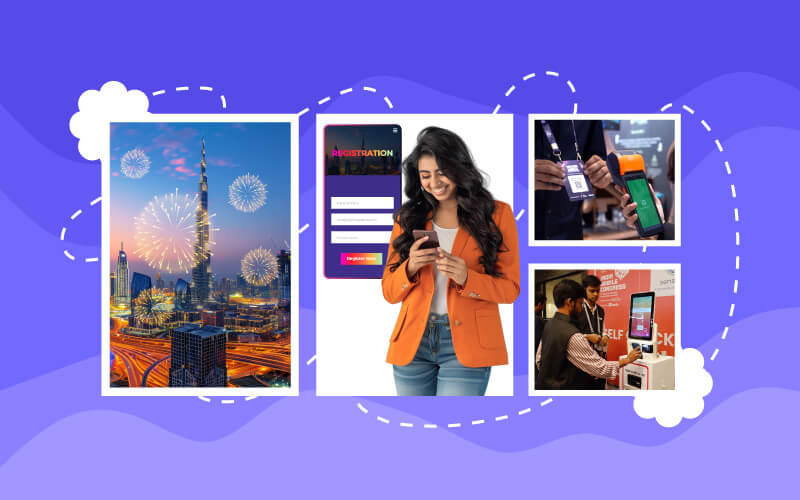An event registration link is considered to be more than just a digital web address. It’s the key to the event’s success. Whether it’s a conference, trade show, or seminar, a registration link for the event is where it begins. It’s a virtual gateway for the attendees, where you can make the first impression and lay a smooth foundation.
However, the online registration link for the event does more than just collect names or emails. It’s more about ensuring that every attendee has a seamless and engaging interaction with the event. In addition, a well-structured sign-up link for events assists in streamlining the various aspects of event management. Manage essential data, event ticket sales, enable secured payments, automate communication and whatnot!
In this blog post, we’ll delve into how to create, optimize, and promote an effective event registration link with the tools and strategies needed to make your event a standout.
What is the Event Registration Link?
An event registration link is a unique web address that directs potential attendees to register for an event. This page allows users to sign up, register, and complete the necessary steps to confirm their participation. By following this registration link for the event, attendees can access all relevant event information and finalize their registration process efficiently.
Moreover, this signup link for the event serves as a crucial entry point for an event that enables attendees to register freely. In addition, the registration link often integrates with a payment gateway and allows attendees to purchase tickets, select seating options, or make donations directly through the link. While accessing the event registration form, view event details, and complete their sign-up process.
In simple terms, “ The primary purpose of online event registration links is to collect essential attendee information, manage participant numbers, and streamline communication between event organizers and attendees. These sign-up links for events are used across a wide range of events, including seminars, conferences, workshops, trade shows, social gatherings, networking events, classes, and fundraising activities.”
Different Ways to Set up Online Registration Link for Events
Here are the top ways to set up online event registration links, from the event registration platforms to QR codes and more! Let’s quickly delve into:
Event Registration Platforms:
One of the top-tier ways to optimize online event registration is by choosing a registration platform. It is also known as an event management system with complete end-to-end event solutions. Organizers can rely on these platforms as they function as centralized hubs where participants efficiently manage their registration process.

Moreover, a digital event ticketing platform provides online and customizable registration forms, secured payment gateways, attendee management, event registration analytics and tools, automated email, reminders, and updates.
As a result, by centralizing all these aspects, event organizers can save time, eliminate excessive administrative tasks, and ensure a professional and streamlined experience. For instance, Dreamcast offers robust event registration features, including digital event ticketing and customizable mobile event apps. An essential component of this process is the event registration link for the event, which directs attendees to a dedicated event registration page where they can easily sign up and manage their participation.
CRM Systems: Advanced Integration for Event Registrations
When it comes to managing event registrations for an event, the CRM (Customer Relationship Management ) system also assists with a high-level approach when it’s integrated with the event registration platform. Event organizers can refine marketing campaigns and enhance attendee experiences through it.
However, event CRMs typically serve as additional tools rather than standalone registration solutions. Moreover, event organizers can easily centralize attendee data and track interactions during the entire event. This approach leads to increased engagement and repeat attendance for future events.
Social Media: Leverage Platforms for Event Registration
Besides registration platforms and event CRM, social media platforms are another way to take registration. Nowadays, events are being promoted online, and it’s becoming a popular trend among event organizers.
According to a survey conducted in January 2018, 30 per cent of U.S. marketers focused on attendee acquisition found social media to be very effective in attracting new event attendees. For example, an event planner can use Instagram or Facebook posts to send their invites and take registrations from there. Therefore, for more registrations, leverage the broad reach and engagement feature of social media by:
- Creating Event Pages: Set up dedicated event listings on platforms like Facebook, Instagram or LinkedIn.
- Distributing Invitations: Send invites to targeted networks and track responses.
However, social media also comes with its drawbacks. Let’s know about it:
- Limited Control: The presentation and visibility of event registration posts are subject to platform algorithms and policies, which can impact effectiveness.
- Data Ownership: Attendee data is controlled by the social media provider, which also limits direct access and control over user information.
Therefore, the pro tip is that social media are useful for increasing event visibility but it requires integration with other tools to manage the full event registration process effectively.
Email Campaigns: Targeted Outreach for Registrations
Email campaigns are a powerful tool for targeted communication and registration management. By creating segmented email lists based on criteria such as past attendance or demographic data, organizers can ensure their messages reach the right audience. Leveraging automated drip campaigns, A/B testing and performance tracking enhances engagement and conversion rates, making the campaign more efficient.
According to a study, there are 4 billion daily email users. This number is expected to climb to 4.73 billion by 2026. However, challenges arise when these campaigns are not integrated with a registration system. Manual processing of email registrations can become error-prone and labour-intensive, and managing automated responses and timely updates requires meticulous configuration to avoid attendee confusion or missed communications. To maximize effectiveness, email campaigns should be paired with a dedicated registration platform, which streamlines the logistics of attendee sign-ups and data management.
Google Forms: Basic and Free Registration Solution
One of the easiest and simplest ways to design a sign-up link for the event is by leveraging Google Forms. It offers a straightforward and no-cost solution for creating online registration forms. Plus, its user-friendly interface provides intuitive designing tools for creating custom forms with layout adjustments to fit event-specific needs.
However, Google Forms lacks advanced capabilities that are often critical for complex event management. For instance, there’s no built-in support for payment processing and all the registration data is handled manually, which increases potential errors. Despite these limitations, Google Forms is a viable option for small-scale events or those with minimal registration requirements. but it may require additional tools to align with event management needs.
QR Codes: Simplifying Access to Registration Links

Lastly, QR codes are one of the best ways for attendee registration linking; being a modern and convenient method, they are a popular choice for event hosts. QR code technology can be linked with event registration forms, websites, and mobile apps and then further utilized for physical promotions such as flyers and posters, as well as digital campaigns. As a result of QR code integration with dedicated registration URLs, organizers can streamline registration links for the event, while increasing accessibility, although QR code generation and management require additional set up and testing.
Read More: Benefits of QR Code For Events
How to Create a Seamless Event Registration Link?
If you’re thinking of creating a seamless attendee registration page, then here’s a step-by-step guide on how to create a sign-up link for the event using an event registration platform.
1. Define Your Event Objectives
Before creating an event registration page, it’s important to outline the requirements and goals that you need from the attendee registration page. Identify the event type, ticketing options, and information collection from attendees. Make sure to define what’s success for your event. It could be anything like specific targets for sign-ups, completion rates, or the efficiency of data collection.
2. Choose the Right Registration Platform
Now comes the essential step: choosing an event registration & management platform that aligns with your needs. Before selecting a platform, ensure it offers features such as customizable event registration forms, secured payment processing, and in-depth event data analytics. Not only this, the chosen platform must integrate seamlessly with other tools like event CRM, marketing automation tools, and more.
3. Design Your Event Registration Form
After finalizing the platform, make a list of information that you need from attendees. This information commonly includes fields such as name, email address, phone number, and ticket type. For more complex and large events, organizers might need additional fields like dietary restrictions, event registration analytics or accommodation preferences. In addition, choose a platform that offers customization features so that you can tailor to the event’s specific needs. For instance, if it’s a conference with multiple sessions, include fields where attendees can choose their sessions.
Pro Tip: Keep the form user-friendly. Use a clean layout, logical flow, and clear instructions. Eliminate unnecessary fields, and see a change with increased completion rates.
Read More: Tips for Event Registration Form
4. Create a User-Friendly Registration Link
To create an easy-to-share, simple event registration link, use URL shortening services like Bitly or a custom domain. Not only does this improve the link’s appearance; in fact, it makes it more user-friendly. Consider including a pre-fill information option for repeated attendees to make the process quick and easier. After generating the sign-up link for the event, dry-test it by sharing it across different devices and browsers to ensure if it works or not if it’s responsive or if there are any technical issues in it.
5. Implement Payment Processing
For paid events and ticket sales or donations, ensure the payment gateway is secure and reliable. Choose the right platform that includes secure payment gateways like Stripe, PayPal, or Square that offer secure payment solutions. However, consider providing multiple payment options to different attendees, such as credit/debit cards, digital wallets, and bank transfers. After receiving payment and successful registration, send confirmation emails and receipts to attendees. This reassures them that their registration was successful and provides them with essential event details.
6. Promote Your Registration Link
Promoting a registration link is equally important as creating a sign-up link for events. Include the attendee registration page in targeted email campaigns. Tailor messages to cater to a diverse audience for better engagement. Leverage social media platforms, run ads and utilize posts to reach a wider audience and drive traffic to the event registration page.
7. Monitor and Optimize
To gauge the event performance, use event registration analytics tools to monitor the registration link. Track metrics such as click-through rates, conversion rates, and drop-off points. Make changes as needed to optimize the event registration process. Analyze the data to identify potential areas of improvement. Besides, collect feedback from attendees regarding the registration process. Use surveys or direct feedback to identify any issues or areas for improvement.
8. Provide Support and Assistance
Lastly, don’t forget to offer support for any technical issues attendees might face during the sign-up link for an event. Be prepared with help from the registration desk or support team. Moreover, consider creating a FAQ section for attendees related to all challenges in event registration and providing instant assistance.
Read More: 5 Unique Event Registration Desk Ideas
Conclusion
In conclusion, creating an effective event registration link involves careful planning and execution to ensure a smooth and engaging experience for attendees. By defining event objectives, selecting the right registration platform, designing a user-friendly form, and implementing secure payment processing, event organizers can streamline the registration process. Additionally, promoting your sign-up link for the event through targeted campaigns and monitoring performance with analytics allows for continuous improvement. Furthermore, with these strategies, one can craft a seamless attendee registration page along with an experience that not only attracts attendees but also supports the overall success of your event.








